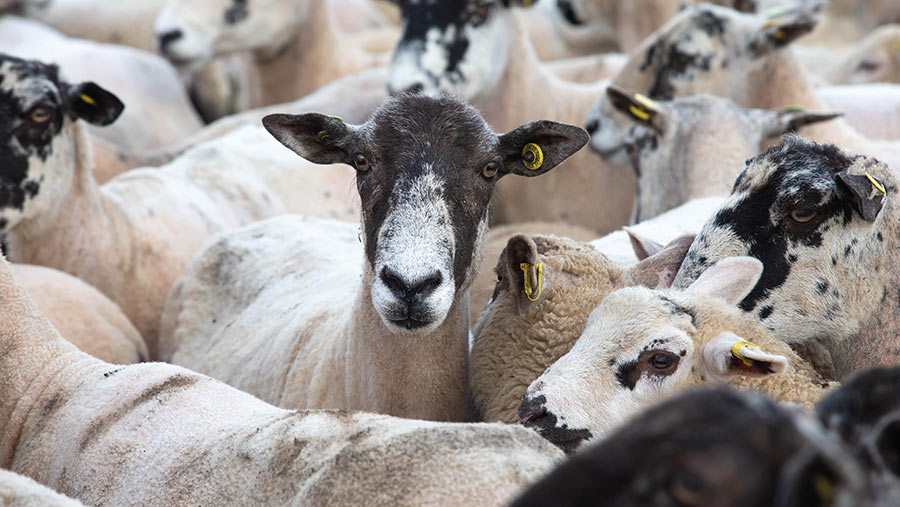Sheep vaccines: 5 steps to using them effectively
 © Tim Scrivener
© Tim Scrivener Vaccinations in sheep play a key role in protecting flock health, and in most flocks will be crucial to ensure productivity and profitability.
A huge number of vaccines is available for sheep and the requirement for them, as well as the timings of dosages, will be specific to each individual flock.
A flock-specific plan, drawn up in conjunction with your sheep vet, will determine which vaccines are most appropriate, and when to use them.
See also: Shortages of key vaccines threaten flock health
About the author

Ed Hill is a vet/director at Thrums Vets. He has a particular interest in sheep health and production and has a certificate in Advanced Veterinary Practice.
How does a vaccine work?
A vaccine takes a killed or inactivated pathogen, or a small portion of it, and delivers it to the sheep safely.
In this way, when the sheep comes across that pathogen ”in the wild”, its immune system is able to act more quickly and strongly to eliminate it before disease occurs.
Below is advice about how vaccines should be handled and administered to make the most from your investment in them.
1. Follow the label
Each vaccine will have a specific dosing schedule, and it is very important to follow the instructions carefully.
Many vaccines will require a primary and secondary dose; immunity provided from a primary dose will not be as strong and long-lived as when the second dose is administered.
In fact, a primary dose without its secondary follow up is largely a waste of money.
Other vaccines need to be given at a certain stage in the production cycle – before mating or lambing, for example.
Where multiple vaccines are to be given, it is important to leave a few weeks between them (abortion vaccinations are one notable exception to this), so as not to overload the immune system.
Often this will mean careful planning to fit them in.
By aiming to have replacements selected or purchased well in advance of mating, as well as a compact lambing period, fitting in these vaccines and getting their timings accurate will be much simpler.
2. Administer correctly
When using vaccines, care needs to be taken to administer them correctly. Should the vaccine be given intramuscularly or subcutaneously?
Vaccines given in the wrong place can cause serious harm.
This is easier said than done, especially when dealing with many hundreds or thousands of animals. But do take care to inject in the correct part of the sheep.
Using dirty needles, injecting dirty animals, and vaccinating on a wet day can all lead to trouble too, and should be avoided.
Also, take care not to jab yourself – this can cause serious complications.
3. Check immune status
For any vaccine to be effective it needs to be given to a sheep with a fully functional and unchallenged immune system. This can be a common issue when investigating apparent vaccine failures.
An underlying parasite burden, such as from gut worms or liver fluke, can pre-occupy the immune system, as well as being a drain on blood proteins.
This means an animal may not respond as well to a vaccine as desired.
The trace elements, especially selenium, have a role to play in immune function. Where there is a deficiency, vaccines are likely not to work as well.
Regular monitoring of trace element status of the flock, and supplementation if required, are advised.
4. Store and handle carefully
How you handle and store vaccines needs to be carefully considered.
Most vaccines are required to be stored at 2-8C, yet a recent study found 89% of farm fridges failed to consistently hold this temperature range.
Some fridges were found to be consistently below 0C – low enough to freeze vaccines.
Elevations in temperature and indeed freezing of vaccines may well render them useless.
Investing in a modern fridge that is used for medicines only, ideally with a temperature monitor, is a small price to pay – especially when considering the value of the medicines they hold at certain times of the year.
Efforts should also be made to keep the vaccine appropriately stored on the day of use. If you are out working all day in warm temperatures, use of a cool box is advised.
This would also be appropriate when transporting vaccine back to the farm after purchase. Even with a cool box, they should be taken straight home to be refrigerated.
Most vaccines will require to be used within hours of breaking the seal. Avoid the temptation to put half a bottle back in the fridge for use another day.
At best it is likely to be less effective; at worst you could have introduced bad bacteria into the bottle, that you then inject back into the sheep.
5. Pay attention to detail
Without vaccines, keeping a productive, healthy flock would be very challenging.
Investing in vaccines will always be flock-specific, but, regardless of which vaccines are used, paying close attention to detail about how they are administered and handled will ensure you get the most from them.
